Understanding each and every part of your weed plant's anatomy, and how they each behave, is pretty easy once you know what you’re looking at.
Cannabis seeds are where we kick things off, then the roots reach down, the main stem shoots up, the branches and leaves spread out, and flowering tops round out the party. It’s not overly mysterious, but learning the basics of marijuana anatomy will offer you a much clearer picture of what’s working, what’s struggling, and when the plant’s about to do something interesting.
This is a straightforward look each and every part of the humble cannabis plant, with a focus on what matters when you're growing at home. No matter if you're just a little curious or trying to make sense of the parts of a cannabis plant during a grow, we’ve got you covered here.
Key Takeaways
Seeds, roots, and stems set the foundation for healthy growth
Fan leaves power photosynthesis and show early signs of stress
Sugar leaves are trimmed after harvest, but still contain valuable resin
Bud quality depends on calyx formation, trichome development, grow environment, and growing techniques
Harvest timing should be based on trichome colour, not pistil changes
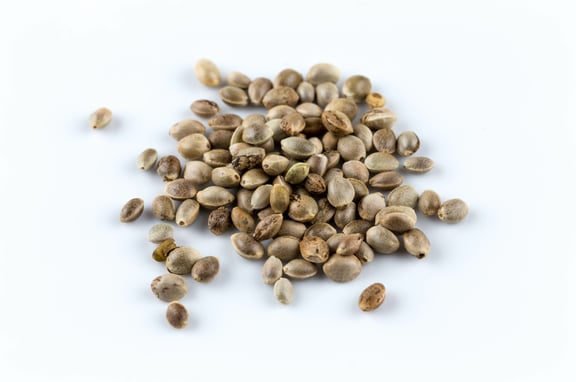
Seeds and reproduction: the beginning of every cannabis plant
Every cannabis plant starts from a seed (unless you’re growing from clones), and every seed starts with a pollinated female. If a male plant releases pollen and it lands on a receptive pistil, that flower will begin producing seeds instead of resin. Once that happens, potency drops and flower quality takes a hit. That’s why most growers remove males early unless they’re breeding.
What type of seed you plant matters. Regular seeds give you a mix of male and female plants. You’ll need to sex them early and remove the males unless you’re after more seeds. Feminised seeds are bred to produce only females, which makes life easier if you’re growing for flower. Autoflower seeds take it a step further by switching to flower automatically based on age, not light cycle.
Strong genetics are everything. They affect how fast your plant grows, how it handles stress, how much it yields, and how potent the end result is. Don’t cheap out here. Weak seeds stall, herm, or grow into something that isn’t worth trimming.
Always buy your cannabis seeds from reputable sources.
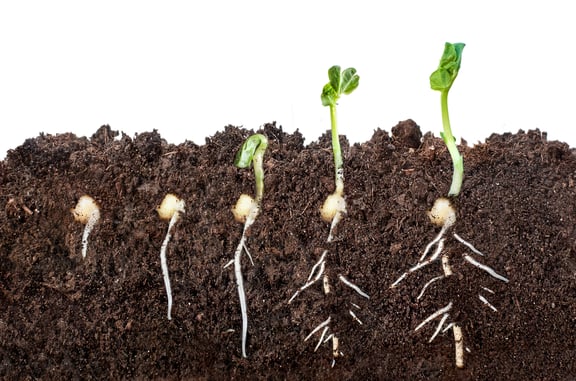
Roots and taproots: The hidden start of a weed plant
The first thing a cannabis seed does is push out a taproot. Once planted (as we usually germinate our seeds above ground), it heads straight down, searching for water, and sets the whole thing in motion. Every part of the plant depends on what happens underground, even if you can’t see it.
From that taproot, a web of lateral roots fans out. Together, they form the cannabis root system. The structure that pulls in oxygen, nutrients, and moisture.
If the roots aren’t strong, the rest of the plant will struggle. Good roots lead to faster growth, fewer problems, and better yields. But only growers using pure hydro will be able to easily investigate what is happening in the root zone, so make sure you have a good growing medium and everything dialled in from the very first day.
What do cannabis roots do?
Roots don’t just feed the plant. They help it breathe and hold it upright. They decide whether nutrients get where they’re needed or stay locked in the soil.
The taproot drills downward, while the lateral roots stretch outwards in search of oxygen and moisture. Between them, they take care of water and O2 absorption, nutrient uptake, and airflow. If the roots can’t get enough oxygen, they’ll stall, and so will everything above the surface.
Common root problems in weed plants
Most root issues start with water. Too much of it, too often - a novice grower mistake through and through. Overwatering cuts off oxygen and creates the perfect conditions for root rot. Once that sets in, things go downhill fast.
Another common problem is when plants get root-bound. This is when the roots run out of room in a pot and begin to essentially strangle themselves. Easy fix - always plant in a potential big enough, or make sure to transplant them with plenty of wiggle room
Beginner tip: Stick with a breathable soil/coco mix, good drainage, and a pot that fits the final size of the plant. It’s harder to fix bad roots than to grow good ones from the start.
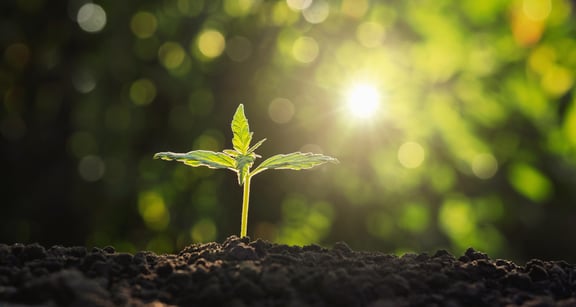
Main stem, nodes, and branches: how a cannabis plant holds itself together
You can think of the main stem as the spine of a weed plant. It supports the majority of weight, channels water and nutrients, and connects everything above the roots. If it’s weak or damaged, growth slows and the whole structure suffers.
What are nodes and internodes in marijuana plants?
Nodes are the points where branches (and the first “true leaves”) pop out. They’re essential parts of a cannabis plant, and you’ll come back to them often, when pruning, during training, and when the time rolls around to work out the plant’s sex.
The spacing between nodes, called internodes or internodal spacing, affects how tall or bushy the marijuana plant becomes. Tight spacing usually means more compact growth. Longer gaps can be a sign of low light or a stretching strain, but it can also just be part of a plants’ genes - Sativa weed strains often have quite large internodal spacing.
How branches influence cannabis yield
More branches mean more bud sites. That’s why growers often top their crop early, to essentially double the number of branches.
Strong branches are important later on, when the flowers start putting on weight. Weak limbs can break. Managed well, a cannabis plant’s structure supports better airflow, better light coverage, and better yields.
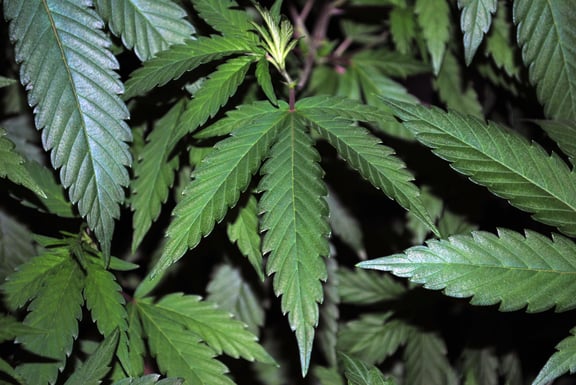
Fan leaves and sugar leaves: What’s the difference?
Cannabis leaves fall into two groups: fan leaves and sugar leaves.
Fan leaves or solar panels?
Fan leaves are the large, easily recognisable leaves that spread out from the main branches.
These are responsible for most of the plant’s photosynthesis. They soak up light and turn it into energy, driving growth, but they can also block airflow and light. Trimming a few of them during the later stages of veg or early flower can help light reach lower bud sites. Watch them for signs of nutrient issues or pests, as they’re often the first part of the plant to show stress.
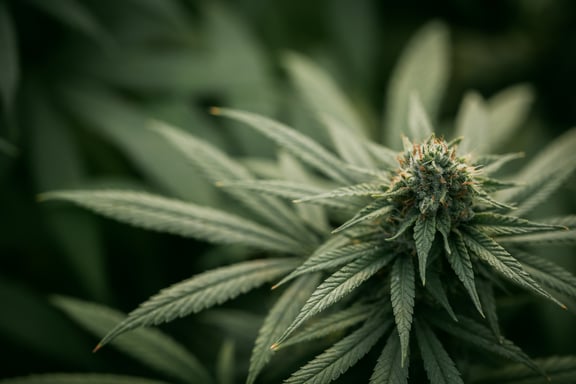
Sugar leaves come later
Sugar leaves are smaller and only start to pump out once the flowering growth stage takes hold.
They grow out of the buds and are, unlike more of the fan leaves, also come with a health sprinkling of trichomes. These smaller leaves help protect the flowers but get trimmed off after harvest - don’t chuck them out with the rest of the junk though, the trichomes that cover them are jam packed with all the good stuff.
You can use them to make edibles and extracts, but they’re not the easiest on the lungs.
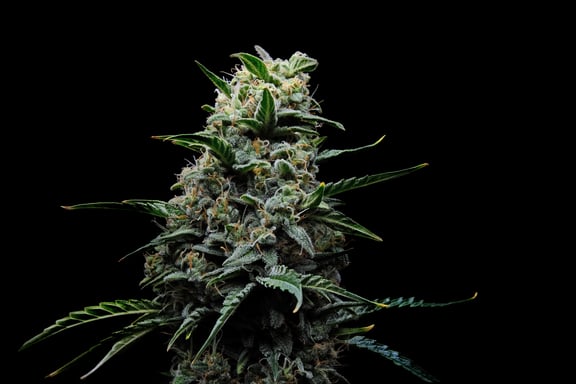
Cannabis bud structure: where potency and flavour live
The buds are what we’re all here for. Pistils, calyces, sugar leaves, trichomes. Stack them together, and you have cannabis flowers.
The calyces form first. They’re small, tucked in at the nodes, and they make up the base of the flower. As preflower kicks in, pistils push out from inside and start out as fine white hair-like growths.
About 10 days into flower, you’ll see the buds properly start to form, and the trichomes begin to show. They start clear and barely visible, but by week three or four they’re coating the calyces and sugar leaves. If your lighting, airflow, and feeding are dialled in, the resin should build fast from here.
How to assess bud quality in marijuana plants
As the plant pushes deeper into flower, the buds thicken and pull in tighter. If they stay thin, airy, or full of gaps, check your environment. Something’s off. We are looking for the density, especially of the buds further up, to be slowly increasing as the weeks go by.
You’ll also see the pistils change colour. They darken, twist, and pull back. That’s a signal, but not the final one. The trichomes tell the real story.
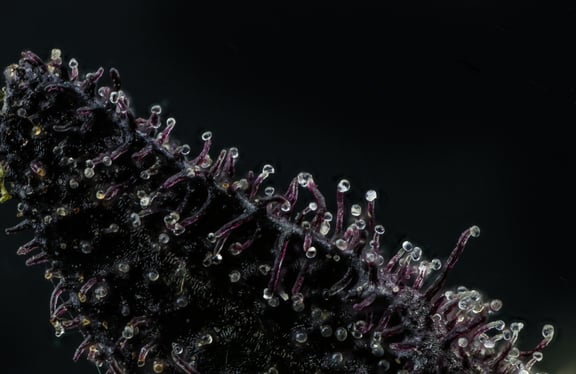
Trichomes: structure, function, and timing
The trichomes are where the magic happens, where the overwhelming majority of the cannabinoids and terpenes are produced, but they also serve a evolutionary purpose. These resin glands are the plant’s defence system. They help protect the flowers from UV damage, extreme heat, and pests. Sticky, bitter, and aromatic, all the good things.
What do trichomes look like under magnification?
You’ll find three types of trichomes on the plant: bulbous, capitate-sessile, and capitate-stalked. The stalked ones are what matter. They’re the largest and most potent, especially during peak flower. Under magnification, they look like tiny glass mushrooms.
Trichomes develop slowly. You won’t see much early on, but by mid-flower, they start coating the buds, sugar leaves, and anything nearby. Their appearance tells you how close you are to harvest.
They start off crystal clear and stay that way through most of the flowering stage. Nothing to see early on. But in the final few weeks, things start to shift. By week six, you should be checking your trichomes every couple of days with a USB microscope. Slowly, they’ll begin to turn cloudy. Then amber starts to creep in.
When around 30% of the trichomes are amber and the rest are cloudy, that’s your harvest window. That balance gives you full potency without letting things degrade too far.
Don’t trust anyone who tells you to harvest based on pistils. Pistils are unreliable. They vary from strain to strain, even plant to plant. Some darken early, some stay white for weeks. They don’t track resin maturity.
The only way to know when your plant is ready is by looking at the trichomes. If you’re not checking those, you’re just guessing.
Final thoughts: know your weed plant, grow with confidence
What we’ve just gone through isn’t second nature to most growers when they first start out, but once you’ve gone through a few crop runs, everything will start making a bit more sense. Just remember to keep a close eye on your plant as it develops, and it’ll tell you everything it needs to know.
The fan leaves will usually be the first indication if something’s going wrong, but as long as you’re paying attention to the full picture, from root zone to flower tips, you’ll catch most issues early. That’s what separates a lucky harvest from a reliable one.
The more time you spend with the plant, the less guesswork there is. Everything you need to know is already there. You just have to notice it.










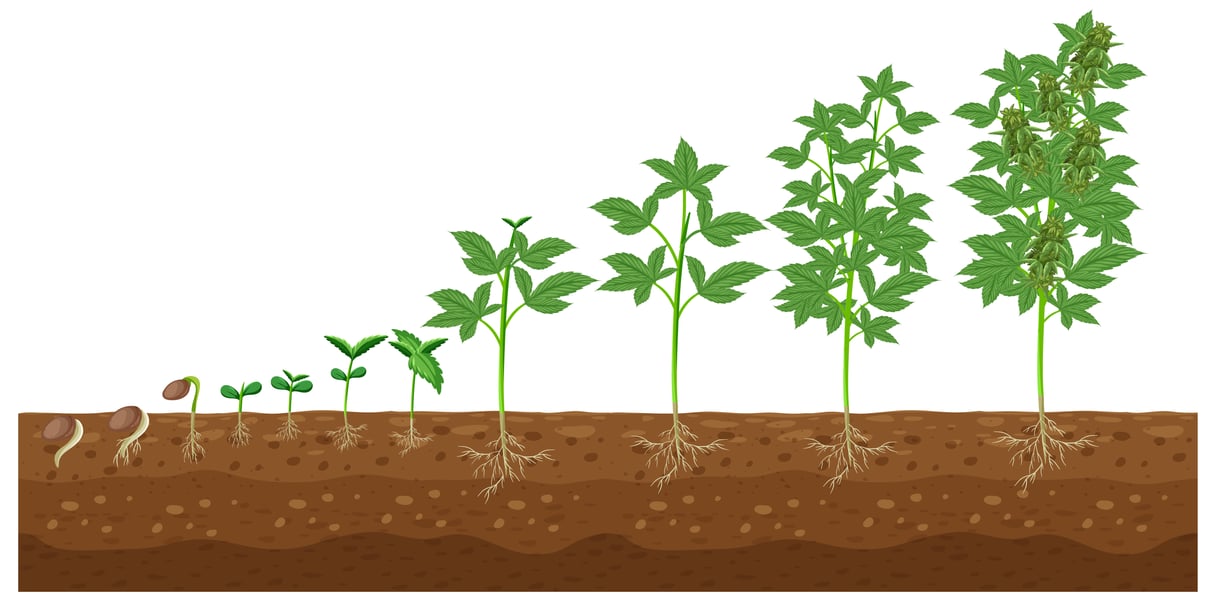

.jpg)